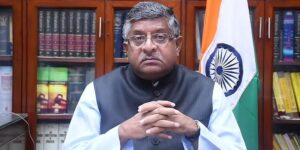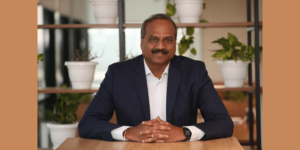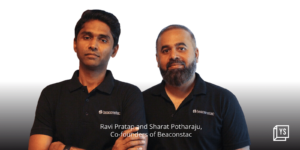
Srikanth Nadhamuni wears many hats—founder, investor, and technologist, among others. But perhaps, you know him best for his work on Aadhaar.
As Founder CTO of Aadhaar, he, along with Nandan Nilekani, played a crucial role in establishing the UID Technology Centre in Bengaluru that developed the Aadhaar technology, instrumental in giving 1.2 billion Indians a biometric-based identity card.
Nadhamuni has also worked on CPU design at Sun & Intel, delved into Interactive TV at SGI, and contributed to healthcare internet startup Healtheon|WebMD.
Besides his contributions to Silicon Valley, in October 2012, he co-founded Khosla Labs, a Bengaluru-based startup incubator, along with Vinod Khosla.
A year later, Nadhamuni, along with Gautam Bandyopadhyay, co-founded the banking fintech company Trustt (formerly Novopay) to make banking accessible, affordable, and simple for the next billion Indians.
Its AI-powered SaaS-based core banking platform helps consumers remit money, withdraw it, make payments, and avail themselves of a variety of banking and consumer-related products and services on its merchant network.
In an interaction with YourStory, Nadhamuni discusses the workings of Trustt and how the fintech aims to make financial services accessible to everyone. Here are the edited excerpts:
YourStory [YS]: What inspired you to build Trustt?
Srikanth Nadhamuni [SN]: While wrapping up my work on Aadhaar, my team had completed registrations for approximately half of the country—crossing 600 million users. In 2011, Nandan Nilekani, Co-founder of Infosys, who first proposed Aadhaar, asked me, “Can you build a bank for a billion people using only 100 people?” And I got obsessed.
A large segment of the population—underbanked or unbanked—faces challenges in accessing banking services.
Initially, we developed payment systems in kirana shops to provide banking services access, especially for migrant workers, who could easily walk in and enquire about banking services.
We noticed that the banking systems we used were old compared to the technology of Aadhaar, which handled millions of transactions. It was outdated and dysfunctional.
That’s when I thought of creating a technology that could scale, reducing the cost of banking. With lower costs, everyone would have access to banking services.
.thumbnailWrapper
width:6.62rem !important;
.alsoReadTitleImage
min-width: 81px !important;
min-height: 81px !important;
.alsoReadMainTitleText
font-size: 14px !important;
line-height: 20px !important;
.alsoReadHeadText
font-size: 24px !important;
line-height: 20px !important;

YS: What makes Trustt different from other players?
SN: Earlier, core banking systems were dysfunctional because they operated with coarse Application Programming Interfaces (APIs) to handle assets, liabilities, and payments. They were limited to basic functionalities such as balance inquiries and withdrawals.
However, compared to a smartphone, the old core banking systems lacked the necessary microservices.
The second challenge was that some banks attempted to create aesthetically pleasing apps and web front ends. While the front end looked good, the back end was somewhat clunky—more like band-aid solutions.
We proceeded to build everything out of the box—mobile apps, web apps, application front end, back end dashboards, and analytics.
Banking is… not some esoteric thing. Drawing from my experience on the board of HDFC Bank, where I chaired the IT strategy committee and risk committee, I was familiar with ratios used to evaluate asset and liability products, net interest margins, and various productivity measures.
In response to the complex landscape of lending, we integrated AI models plugged into the core banking system, providing real-time data for decision-making.
Simultaneously, we addressed common banking challenges such as KYC using Aadhaar, credit and debit card networks, and recurring payments by building connectors for integration.
YS: Are you particularly concerned about safety/security? Are there features in Trustt that ensure data safety?
SN: Contrary to popular belief, cloud-based systems are incredibly secure. I recall a conversation with Amazon CTO Werner Vogels, who said, ‘Many people think somehow if you create a moat around yourself, and the moat is high enough—inside you’re secure. That’s the folly.’ Advanced threats might be present without your awareness.
Measures extend beyond data at rest; data in motion must also be encrypted. The cloud providers are far ahead in technology.
Fintechs, despite their expertise in financial products, often lag behind banks due to their reluctance to leverage innovations in cloud technology, which greatly enhance data storage and security practices.
It’s essential to acknowledge that security is a well-understood problem today. But you can’t solve it completely.
.thumbnailWrapper
width:6.62rem !important;
.alsoReadTitleImage
min-width: 81px !important;
min-height: 81px !important;
.alsoReadMainTitleText
font-size: 14px !important;
line-height: 20px !important;
.alsoReadHeadText
font-size: 24px !important;
line-height: 20px !important;

YS: What’s your take on generative AI (Gen AI)?
SN: About a year ago, I had a meeting with Sam Altman, and he explained certain concepts that made me realise that this [Gen AI] is going to change everything. You suddenly find something that moves the Earth; Gen AI is something like that.
Two key realisations dawned upon me. Firstly, revisiting the challenge of financial inclusion, attempting to address the question Nandan asked about 12 years ago—to reimagine banking.
Secondly, picture this scenario for a villager—having a friend employed at the bank who not only speaks the same language. Consider how it would be to simply pose questions like, ‘Can I secure a loan to purchase a buffalo?’
With the help of conversational UI, this person can express themselves in their native language. We started working on the development of a technique known as RAG (Retrieval Augmented Generation), and surprisingly, we achieved progress.
Goldman Sachs spent $150 million last year solely on customer support for Apple. Customer interactions are expensive. Instead, can you have AI do that?
I also lead a project within the healthcare sector, which focuses on establishing ICUs in government hospitals. Present in over nine states, a virtual nurse—the Ayushman AI Specialist—was designed to operate during critical situations. We are working with Open AI on this project.
YS: Please tell us more about your current sales performance and funding.
SN: We run the company [Trustt] quite differently from a lot of startups. We have been profitable for 3-4 years now. During a recent visit to New York, we showcased TrusttGPT to major banks, which left many shocked.
We are excited about our growth in India and are exploring opportunities in Southeast Asia and possibly the US.
The solution can be utilised by small finance banks, MFIs, fintech, and ecommerce companies, and also extend to physical transactions in over one lakh locations, including kirana shops in various states in the country.
YS: What drives you and what brought you back to India?
SN: Earlier, I was in California, shaping chips as a designer at Intel, along with constructing CPUs. But there was always a nagging feeling that you come from a land where a lot of people don’t have access to so many things.
I couldn’t just sit there and build faster chips for fairly developed economies, while even the basic things are not met in India. So, I moved back in 2002.
Then I met Nandan Nilekani, which led me to improve governance and systems across the country. Now, I am looking at healthcare as one area because, after COVID-19, I was devastated by the number of people who died that I knew.
Being a part of the ethics committee at the Ministry of Education, we are working on setting up AI centres of excellence for agriculture, health, and sustainable cities. I aim to contribute to projects where we can make a noticeable difference.
Edited by Suman Singh










